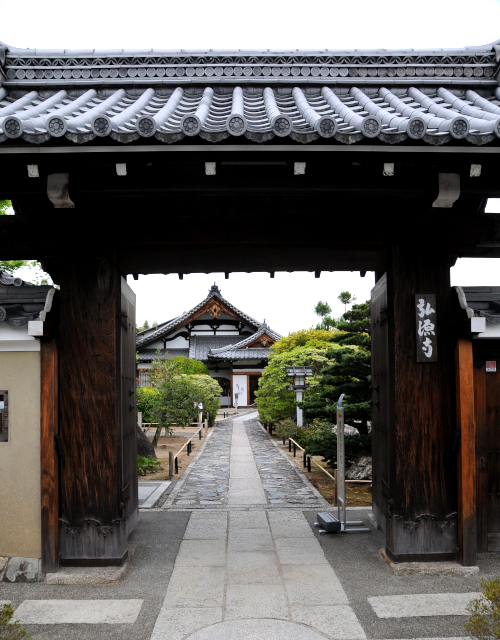Tiny Kogen-ji is one of the subtemples of Tenryu-ji in Arashiyama. For Kyoto standards, it is comparatively new, having been established in 1429 by a high-ranking official in the Muromachi Shogunate, Hosokawa Mochiyuki. The name Kogen-ji is derived from Hosokawa’s posthumous Buddhist name. Kogen-ji was originally located at the foot of Mount Ogura north of Tenryū-ji, but following a number of fires it was relocated to its present site in 1882.

Because the temple is so small, its main attractions are the temple’s treasures. It has a number of paintings by Takeuchi Seiho and his students. Takeuchi Seiho (1864-1942) was a nihonga style painter and extremely influential in Kyoto’s artistic circles throughout his career. He is most famous for his paintings of animals that incorporated a realism usually found in Western art at the time. Takeuchi was friends with the head priest of Kogen-ji, and when his son Shiro fell ill, he was allowed to convalesce at the temple. Despite the lovely surroundings, it must have been a relatively dreary place, so Takeuchi’s students created many paintings to cheer up Shiro; their paintings that are held at the temple to this very day.

Staying with paintings for a moment, before entering the main buildings, the Bishamon Hall lies on the left side of the path. The plaque above the entrance features calligraphy by famous priest Kobo Daishi (774-835). Inside, there is a wonderful ceiling with 44 paintings of flowers of all the seasons, created by Fujiwara Fuseki, also a nihonga painter. The colors are very lively, so the ceiling must be comparatively new.

The rest of this building is subdued as usual, so as not to distract from the main image, a beautiful standing statue of Bishamonten, a god of war. It dates back to the 9th century, and the graceful curve of his body as he slays a demon is worth a closer look. Unfortunately, the hall may not be entered, but there is a life-size photo of the statue at the entrance.

Further down the path lies the main hall, built in the early 1600s. It is made in a residential style rather than in classic temple architecture. Maybe this was the reason why in 1864 samurai of the Choshu domain army bivouacked at Kogenji and Tenryu-ji. Before their attack on the Imperial Palace, they tested their swords on the wooden pillars of the main hall. To this day, you can see the cuts the made in the wood; however, the swords were not sharp enough to win them the battle.

Of course, Kogenji wouldn’t be a proper Zen temple without gardens. The Lion’s Roar Garden is the main garden of the temple. It is a typical dry garden with a big sea of grey sand, but the hedges surrounding it add a splash of color. There is also a garden at the back of the main hall, which has lush greenery and must look lovely during the momiji season Arashiyama is famous for.

Overall, I’d say Kogenji is nice to visit if you’re looking for a more quiet place and if you like nihonga paintings. Otherwise, skip it in favour of Hogonin, another sub temple of Tenryu-ji or the main halls of Tenryu-ji itself.
